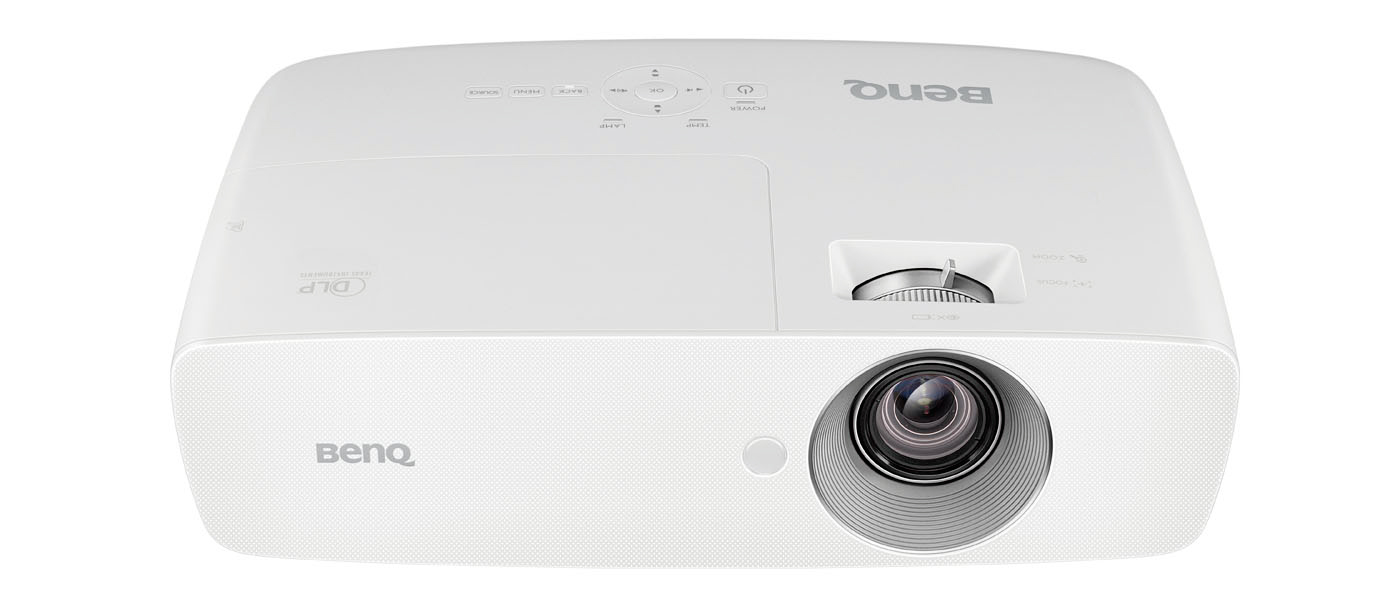With 3000 lumens and lens shift, it offers tremendous value for enthusiasts on modest budgets. For less than the price of a decent HDTV, you can have an image up to 300 inches that has enough punch to compete with room lights. 80-inch televisions are nice but wouldn’t you rather have 200? The 3700 can deliver just that.
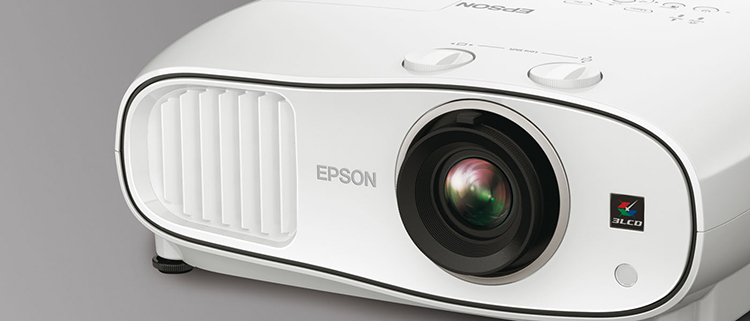
Epson Home Cinema 3700 LCD Projector
- Vertical and horizontal lens shift
- 3000 lumens output
- Full calibration controls including a color management system
- 3D
- Built-in speakers
- Compact chassis
- High-quality lens
Epson’s 3LCD light engine is one of the most versatile technologies in the industry. It’s been used in every kind of projector, from inexpensive portable and boardroom models to high-performance theater displays worthy of any picky videophile’s consideration. While I always enjoy checking out the latest flagship, there is a tremendous amount of performance available from its value-priced models.
Panel type:
3-chip LCD
Native aspect ratio:
16:9
Native resolution:
1920 x 1080
Anamorphic lens support:
No
3D formats:
Frame-packing, Side-by-side, Top-bottom
2D-3D conversion:
Yes
Throw ratio:
1.32 – 2.15
Lens Shift:
60% vertical, 24% horizontal
Light output (mfr):
3000 lumens
Contrast ratio (mfr):
70,000:1
Iris Control:
2-speed Auto
Image size:
30” – 300”
Inputs:
2 HDMI 1.4a (1 MHL), 1 VGA, 1 USB
Audio:
1 3.5mm output
Speakers:
2 x 10 watt
Lamp power:
250 watts
Rated lamp life:
5000 (Eco) / 3500 hours (Normal)
Dimensions:
6.4" H x 16.1" W x 12.0" D
Weight:
15.2 lbs
Warranty:
2 years
MSRP:
$1499
Company:
SECRETS Tags: Epson, Home Cinema, LCD Projector, Projector Reviews 2017
Epson has put a lot of effort into the refinement of its high-brightness designs. Three years ago, they started by adapting boardroom models to home theater and media room specs with accurate color, gamma and white balance delivered right out of the box. High output has now found its way to the Home Cinema series and to the low end of the price spectrum.
Today I have the Home Cinema 3700 in my theater. It’s capable of 3000 lumens and has lens shift, full calibration controls, a high-quality lens and 3D all at a super-competitive price of $1499. I’ve seen great things from its more expensive stablemates like the Pro Cinema 6040 and LS10000. Can this modest machine keep up Epson’s benchmark standards? Let’s take a look.
There isn’t much more to say about Epson’s 3LCD engine that hasn’t already been reported. How do they continue to add value year after year? By increasing light output and getting greater brightness from the same bulb power. The Home Cinema 3700 manages tremendous light levels from a 250-watt lamp. That means power consumption is reasonable and you have an image that can easily compete with some room lighting. Add a light-rejecting screen like Screen Innovations’ Black Diamond and quality increases further.
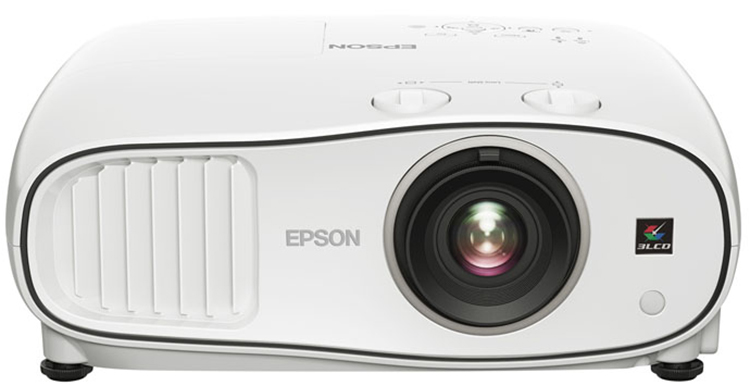
The 3700 is compact but you won’t mistake it for a portable. At just over 15 pounds, it’s a little bulky for a satchel or backpack. But if you do take it on the road, it offers sufficient connectivity for presentations and two 10-watt speakers around back which are fed by the HDMI inputs.
The lens is off-center to make room for a generous exhaust vent. Fan noise is non-existent in the bulb’s Eco mode but you will hear a dull roar when it’s on High. Considering the projector’s prodigious light output, it’s a small price to pay. Put it up on the ceiling and you won’t know it’s there. Two adjustable feet help level the unit so you can hopefully avoid the resolution-robbing keystone control.

It wasn’t long ago that lens shift would add significantly to the cost of a projector. It seems that is no longer the case. The 3700 has 60-percent vertical and 24-percent horizontal adjustments to help position the image precisely. Zoom and focus controls are on the lens ring which you can see in the above photo. All move with firm precision and retain their settings once established. The optics are first-rate and I was impressed with the sharpness and uniformity of the image once installation was complete.
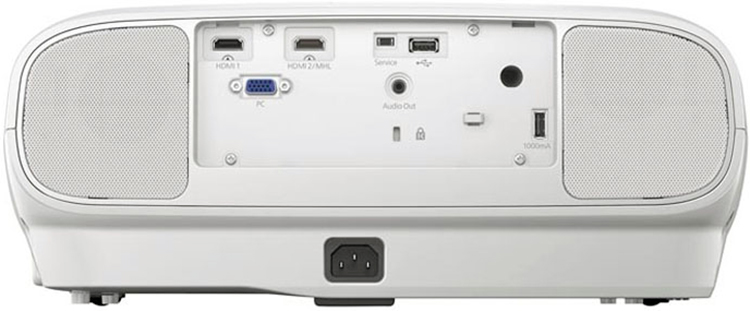
The input panel seems minimalist but everything one could need is there. There are two HDMI ports, one of which supports MHL for mobile devices. The USB port handles JPEG slide shows. If you want to pipe audio to an external system, there’s a 3.5mm jack for that purpose. Finally, a VGA connector handles analog video. Component and composite signals can be carried using a breakout adaptor which you’ll have to source on your own.
Secrets Sponsor
Epson’s projector remotes are without peer. They are always solid, functional, responsive and most importantly, backlit. Starting at the top, we have discrete power keys and a backlight button. That’s followed by individual input selectors. The transport controls will work with HDMI-CEC-enabled products. Direct-access controls select the 3D format, color mode and image enhancement options. Then there’s menu navigation and at the bottom, more function keys for things like the CMS, frame interpolation and the like. A User button can be programmed in the on-screen menu for select functions.

The 3700 doesn’t ship with 3D glasses but I got a pair of Epson’s latest with my review sample. They’re light and comfortable and can be worn for long periods without fatigue. They fit over my prescription specs with ease. A slider switch turns them on and off and a pairing button syncs them with the projector. They operate via RF so line-of-sight is not required. A USB charge port provides enough juice for several hours of operation. Viewing options can be adjusted in the menu and 3D conversion is supported for 2D content.
Like all Epson projectors, the Home Cinema 3700 has a large and comprehensive setup menu. Every conceivable option is there for calibration, geometry, 3D, signal formats and many more. If you can’t find what you’re looking for here, you probably don’t need it.
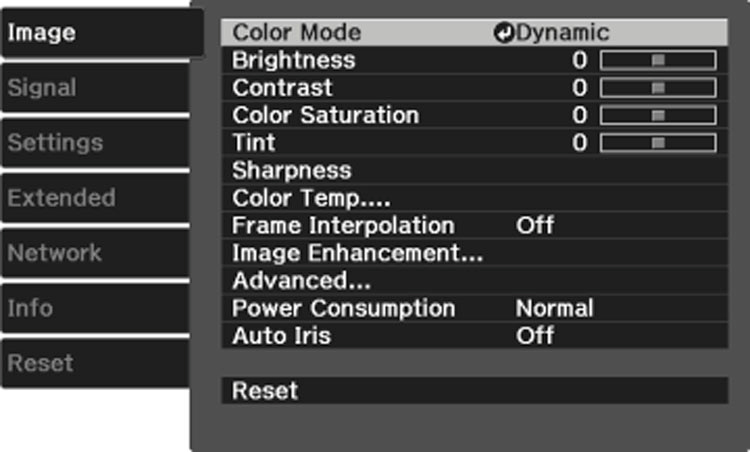
After installing the projector on a tall stand in back of my theater, I spent an afternoon exploring the menu as I always do. The Image sub-menu has all the necessary calibration options including a two-point white balance, gamma presets with editor and a full color-management system. Those options are found under Color Temp and Advanced respectively. I found the 3700 needed very little tweaking and its out-of-box grayscale tracking is almost perfect. My calibration consisted merely of a few changes to the CMS to improve color luminance balance and secondary color hue.
There are four picture modes plus two additional presets for 3D. Natural, Cinema and Bright Cinema have similar characteristics and offer good out-of-box performance. Dynamic is probably best left for bars and very large spaces because it pumps out an eyebrow-melting 162fL. The first two are good starting points for calibration but all the modes are fully-adjustable.
Secrets Sponsor
Image enhancements are many and users can easily become lost when experimenting with all the options. Epson has simplified this process with Image Preset Modes. There are five levels where each one applies a greater level of enhancement. Settings above 3 produce ringing which I could see in both test patterns and actual content. You can manipulate sharpness and other options separately if you wish but I found the best picture in Image Preset Mode 3 and left the rest of the controls alone. If you want to use Frame Interpolation, there are three levels plus off. It works fine for sports but unless you like the soap-opera effect, leave it disabled for movies and TV shows.
The bulb has three power settings, all of which provide tremendous output. Eco will give you the longest service life and almost no fan noise and it still pumps out over 80fL after calibration. Native contrast is decent at over 2100:1 but if you want more depth, engage the auto-iris. It has Normal and Fast settings of which the latter works the most seamlessly. It works well without crushing highlight and shadow detail and it bumps sequential contrast to over 25,000:1. My one complaint is that output can only be controlled with bulb power. With so much light available, this projector could really benefit from a manual iris in addition to the automatic one.
Other features of note include a panel alignment procedure that helps improve convergence. My sample had been adjusted already but I found it barely necessary. The 3700 is built with good quality control and shouldn’t need much tweaking in that area. I should also point out the HDMI Video Range and Epson Super White options. Both extend the signal handling of the projector to pass above-white and below-black information. If video content is encoded correctly, it won’t have those levels. Leaving them at their default settings will maximize dynamic range.
In my opinion, the principal factor in deciding which value-priced projector to buy comes down to LCD versus DLP. I have reviewed dozens of samples using both technologies and still conclude that there is no clear advantage to either. LCD offers superior contrast while DLP has the edge in clarity. Of course, the ideal display excels at both but that usually means spending more money.
The Epson Home Cinema 3700 performs well in both areas. Its lens throws a super-sharp image that looks amazing from edge to edge. And it has very good contrast. It won’t be mistaken for an LS10000 or even a Pro Cinema 6040 but with the iris engaged, you’ll experience some seriously impressive black levels.
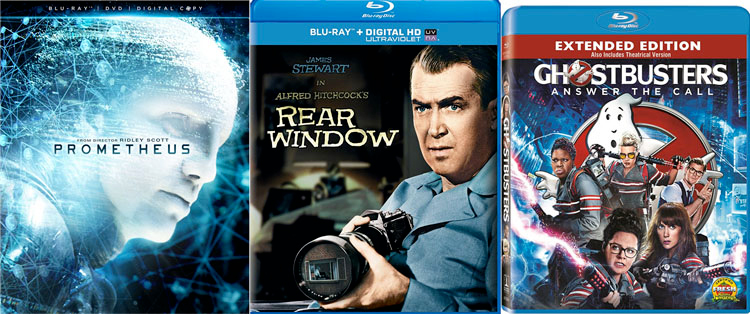
I started with my favorite shadow detail torture test, Prometheus. There are many scenes shot in deep caverns where reflections and small flashlights are the only source of illumination. When light does hit the walls, you can see fine textures, angles and features that only the best displays can render. With the iris off, the 3700 still resolves the detail but the overall look is a bit gray. Turning the iris on takes it down to a deep black with absolutely no crush. Epson continues to provide the best auto-iris in the business. It’s great to see a technology evolve to where a manufacturer can include it in all its products, at all price points. Color looked fantastic as well with rich hues that popped from the screen.
I like to stick with familiar material so I re-watched Alfred Hitchcock’s Rear Window, which I had viewed just a day ago on my Pioneer plasma TV. Seeing the film on a big screen revealed a lot of film grain and other flaws courtesy of a restored print from 1954. Movie lighting in those days is far more flat and harsh than it is today and I found watching in total darkness to be a bit fatiguing. Color held up well and remained vivid but I was suddenly inspired to turn the lights on.
When I review a light-rejecting screen, I always watch some content with the lights on; but I don’t typically do that for projector reviews. This time however, I was astonished at how good the image looked. Remember that I’m using a Stewart Filmscreen product that is designed for use in total darkness. Even with lights pointed at the screen, I was able to see good contrast, color and resolution. Epson is taking high-brightness to a new level with the Home Cinema 3700
I followed with another bright and colorful release, 2016’s Ghostbusters. This Blu-ray also proved to be too bright for dark-room viewing but looked fantastic with the lights on. It truly was like watching a jumbo television in the living room. I was wishing I had an SI Black Diamond or Seymour Ambient Visionaire on hand because the picture would have been even better. Of all the high-bright projectors I’ve reviewed so far, the 3700 provides the best lights-on image yet.
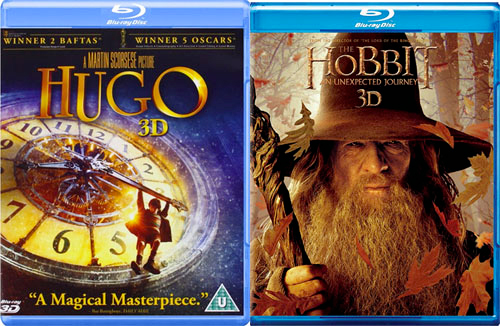
The Home Cinema 3700 pumps out over 15fL in 3D mode, more than any projector I’ve reviewed to-date. With that in mind, I was expecting killer 3D and I got it. I started off with Hugo, which has a great sequence in chapter 7 where the two main characters walk through a black tunnel lined with pipes. The 3D effect was superb with no ghosting visible. Contrast remained deep with excellent black levels and rich detail. Color is also natural and vivid in 3D mode. I should also add that the projector switches modes very quickly. By the time you’ve settled into your chair and turned the glasses on, the display is ready for action.
Another go-to 3D Blu-ray for me is The Hobbit, an Unexpected Journey. It’s a conversion from 2D so its sense of depth is more subtle. Some displays barely register a 3D look when showing it. While I could tell the stage was more shallow, it still drew me into the scene thanks to high clarity, smooth motion processing and great contrast. It should be noted that the two 3D picture modes can be independently calibrated.
To measure the color accuracy of the Home Cinema 3700, I used an i1Pro spectrophotometer, along with an Accupel DVG-5000 signal generator and CalMAN 5.2 to control the instruments and crunch the numbers. Luminance tests were performed with a Spectracal C6 tri-stimulus meter.
The 3700 ships in its Bright Cinema mode with the iris set to Fast and the lamp on Medium. That’s a tremendous amount of output for my relatively small theater so I dialed back to Eco and turned off the iris to measure the projector’s native contrast and gamma.

As you can see, grayscale tracking is incredibly close to perfect right from the start. In fact, I don’t believe I’ve seen such accurate results before calibration from anything but a factory-tuned professional computer monitor. Gamma doesn’t fare as well however. It’s very light which makes the picture bright but washes out detail as the signal level increases. The reason for this is intentional on Epson’s part, it boosts color brightness which helps the image compete with room lighting. For my purposes though, I’ll try for something closer to SMPTE specs.

I measured both the Natural and Cinema modes and found the better starting place to be the latter. Natural is similar to the above but its gamma has a small aberration at 90-percent which in turn affects color saturation and luminance. Since all modes are adjustable on the 3700, I made my changes from here.
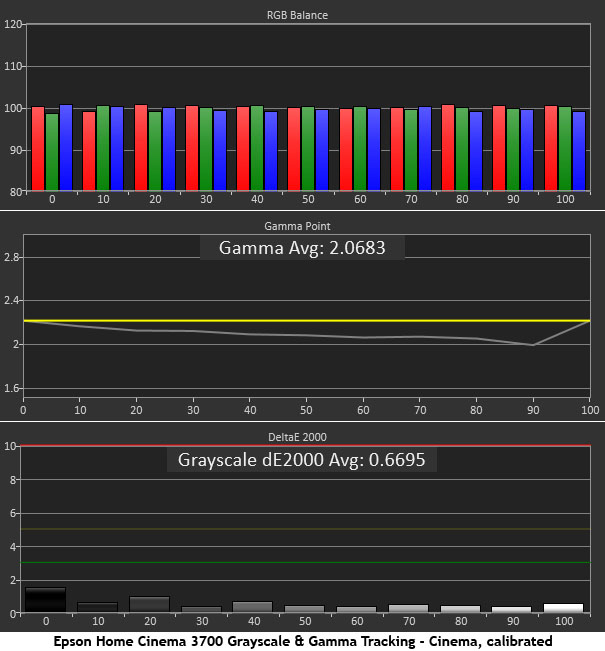
Grayscale tracking is now at reference-level. There isn’t much to say beyond that it’s visually perfect. Gamma is fairly linear but rides just a bit below the 2.2 line. Using the 3700’s presets, I had the choice of settling just above or just below the standard. The latter provided better color saturation and luminance results which you’ll see below.
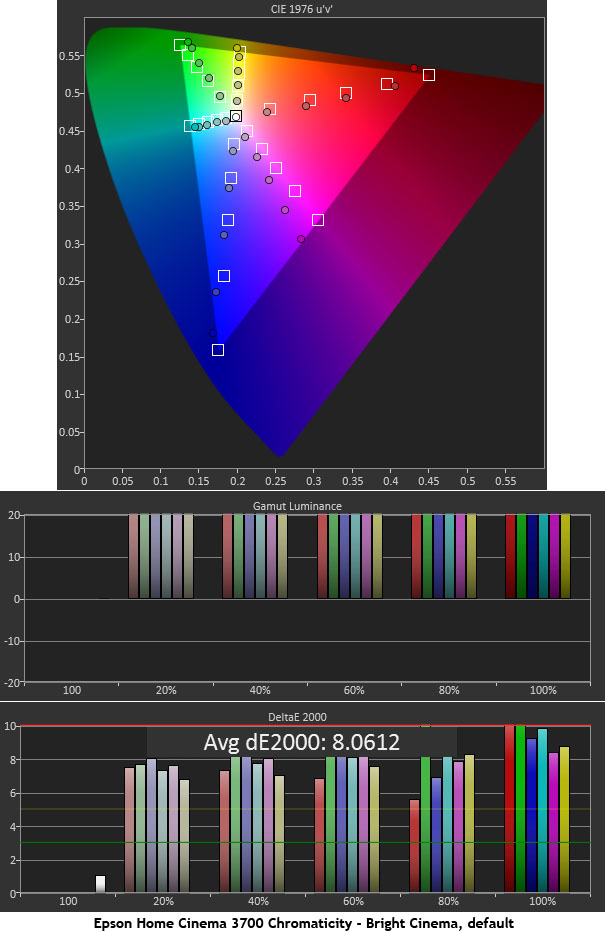
Regardless of picture mode, the 3700’s native gamut is slightly under-saturated. This is mostly compensated for by increased luminance levels. You can’t fix this in the CMS; color can only be reduced in saturation, not increased. But it is possible to balance luminance levels and improve the hues of secondary colors.

By selecting Cinema, I now have better gamma and more-balanced luminance values with which to make my adjustments. Natural mode will generate a similar chart but I’m looking to keep color as saturated as possible within the confines of the 3700’s native gamut.

With a few changes to the color temp sliders and the CMS, the 3700 has reached its peak level of accuracy. Color saturation is pretty much on-target except for the perimeter points which are a little under. That is offset by slightly elevated luminance targets. They’re reasonably well-balanced too which means overall color looks natural without being overblown or washed-out. There is no detail clipping either which enhances image depth and perceived contrast.

The Home Cinema 3700 will pass above-white and below-black signals but only under certain conditions. First you must set HDMI Video Range to Expand. That will give you the additional signal information but it reduces the projector’s dynamic range when brightness and contrast are set correctly. You can also reveal WTW by turning Epson Super White on. I decided to leave both options at their defaults to maximize contrast. If material is encoded out-of-bounds, that detail will be clipped but such instances are rare.
The projector failed to lock on to both film and video mode interlaced signals. 2:2 is a common flaw in most displays but 3:2 is usually not a problem. It simply means you should allow your player to perform de-interlacing tasks. 24p content is correctly rendered via repeated frames. When setting up your source components, the highest resolution will be found with RGB-format signals. 4:4:4 will pass the one-pixel burst too but 4:2:2 will not.
The Home Cinema 3700 is an exceptionally bright projector. It has more than enough output for any size theater or media rooms with ambient light. I suggest a light-rejecting screen for these applications to maximize contrast.
After calibration in the Cinema mode with the bulb set to Eco, I measured a white level of 85.341fL, a black level of .0398fL and a contrast ratio of 2142:1. This is a native value without use of the auto-iris.
Engaging the iris drops white to 74.8959fL, black to .003fL and increases contrast to 25,207:1
Setting the bulb on High (iris off) ups max output to 127.9402fL and the black level to .0582, but contrast remains consistent at 2197:1.
The projector’s maximum output is found in the Dynamic mode. There I measured 162.511fL white, .0594 black and 2737.4:1 contrast.
In 3D with the bulb on High and the iris off, peak white is 15.7985fL, black is .0065fL and contrast is 2422.4:1. This is the highest 3D output I’ve ever recorded from a front-projection display.
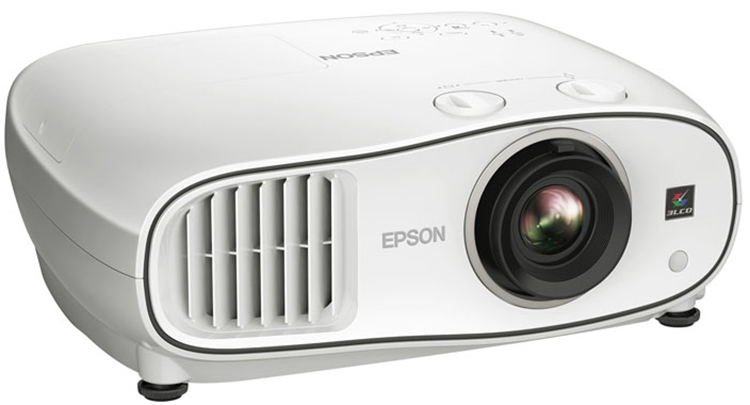
THE EPSON HOME CINEMA 3700 Offers Tremendous Light Output, Good Color And a Sharp Image for Less Than $1500. If You’re Looking to Replace Your Flat Panel TV with a Projector, This One is Hard to Beat.
- Tons of light output
- Sharp lens
- Pre-calibration accuracy
- Lens shift
- Value
- Better primary color saturation
- Better default gamma tracking
- Manual iris for output control
My reference projector, an Anthem LTX-500, cost $8000 back in 2009. When I think about how far Epson has come since then, and how close a $1500 product comes to equaling that Anthem, I can’t help but be amazed. While I’m not taking that venerable unit down from the ceiling yet, it sure looks like its days might be numbered.
When it comes to clarity and brightness, the Home Cinema 3700 has few equals. I’ve looked at many DLPs in this price range but none offer the black levels and superb contrast I witnessed here. While the primary colors are a tad under-saturated in testing, I didn’t find it to be a factor when viewing actual content. In fact, this is the first high-bright projector I’ve reviewed where I could see a decent image on my Stewart Studiotek 130 with the lights on. If paired with a light-rejecting screen, one could absolutely replace their television with this display.
Epson continues to top itself every year. The 3700 is just another example of that. For $1500, you get a top-quality lens, tremendous light output, great contrast, accurate color and an image worthy of even a high-end theater. If you’re in the market for a projector that can truly work well in a lit room, and you don’t have a five-figure budget, I can’t imagine a better choice right now.


